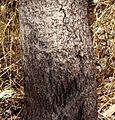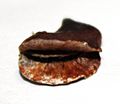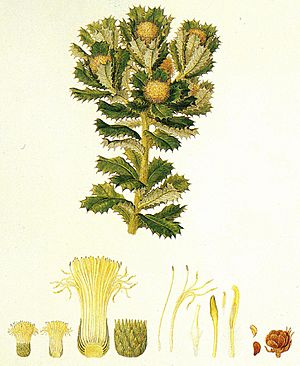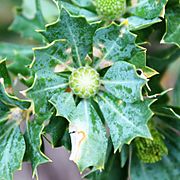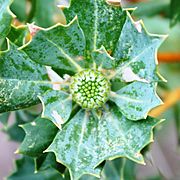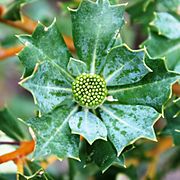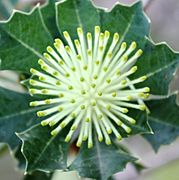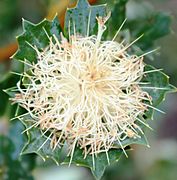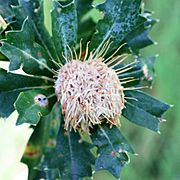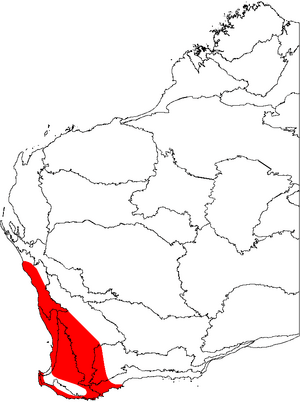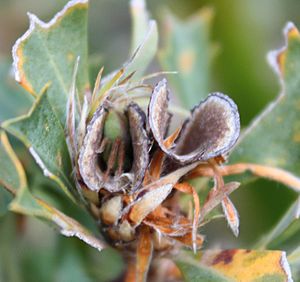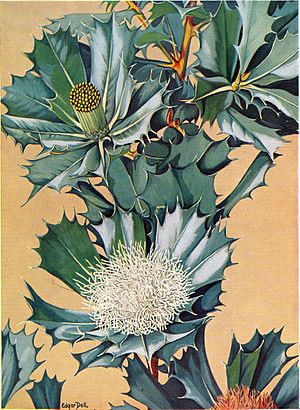Parrot bush facts for kids
Quick facts for kids Parrot bush |
|
|---|---|
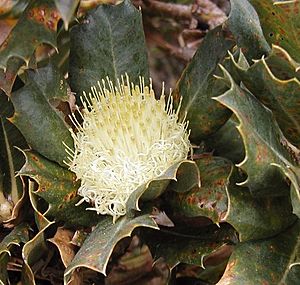 |
|
| B. sessilis var. cordata | |
| Scientific classification | |
| Genus: |
Banksia
|
| Species: |
sessilis
|
| Varieties | |
|
B. sessilis var. sessilis |
|
| Synonyms | |
|
Josephia sessilis Knight |
|
The Banksia sessilis, also known as parrot bush, is a type of shrub or small tree. It belongs to the Banksia plant group, which is part of the Proteaceae family. For a long time, it was called Dryandra sessilis. But in 2007, scientists decided to move all Dryandra plants into the Banksia group. The Noongar people, who are the traditional owners of the land where it grows, call this plant budjan or butyak.
You can find the parrot bush all over southwest Western Australia. It likes sandy soils that are often found over laterite or limestone. It often grows as a smaller plant under taller trees in forests or woodlands. The plant can grow up to 6 meters (about 20 feet) tall. It has prickly, dark green leaves and round, cream-yellow flowerheads. These flowers bloom from winter to late spring. They are a very important food source for honeyeater birds during the colder months. These birds eat the sweet nectar and the insects the flowers attract. Other animals, like the long-billed black cockatoo and Australian ringneck parrots, eat its seeds. The parrot bush is also special because it can survive bushfires. The plant itself dies in a fire, but it produces many flowers and a huge amount of seeds. This helps new plants grow quickly after a fire.
Contents
What it Looks Like
|
|
The Banksia sessilis grows as an upright shrub or small tree. It can reach up to 6 meters (about 20 feet) tall. Most new stems have soft, fine hairs that disappear as the plant gets older. However, one type, B. sessilis var. flabellifolia, usually has hairless new stems.
The leaves are blue-green or dark green and feel prickly. Their shape depends on the variety:
- In var. cygnorum and var. flabellifolia, the leaves are wedge-shaped with teeth only near the tip.
- In var. cordata, they are also wedge-shaped but have teeth all along the edges.
- In var. sessilis, the leaves are wider at the base, sometimes almost rectangular.
Leaves are usually 2 to 6 centimeters (about 1 to 2.5 inches) long and 0.8 to 4 centimeters (about 0.3 to 1.5 inches) wide. They can grow directly from the stem or have a very short stalk.
The flowers are cream or yellow and grow in dome-shaped heads that are 4 to 5 centimeters (about 1.5 to 2 inches) wide. These flowerheads grow at the end of a stem. Each head has 55 to 125 individual flowers. At the base of each head, there are short bracts (leaf-like structures).
Like many other plants in the Proteaceae family, each flower has a tube-shaped outer part called a perianth and a long, thin style. The style is first tucked inside the perianth, but it breaks free when the flower opens. In B. sessilis, the perianth is straight and about 2 to 3.2 centimeters (about 0.8 to 1.3 inches) long, and pale yellow. The style is a bit shorter and cream-colored. This means that when the flowers open, their color doesn't change much, unlike some other Banksia species.
The parrot bush mostly flowers from July to November. One variety, var. sessilis, can start flowering as early as May. After flowering, the old flower parts fall off. Up to four seed pods, called follicles, then grow at the base of the flower head. Young follicles are fuzzy, but they become smooth as they mature. Mature follicles are oval-shaped and about 1 to 1.5 centimeters (about 0.4 to 0.6 inches) long. Most of these follicles open on their own in autumn, releasing their contents: a woody seed separator and up to two winged seeds.
Discovery and Naming
The first samples of B. sessilis were collected by a Scottish surgeon named Archibald Menzies. He found them during the Vancouver Expedition to King George Sound in September and October 1791. Menzies collected many plants, and this was one of the first times this type of plant was found. His plant samples were sent to Sir Joseph Banks in England, but they were not studied for many years.
Later, in December 1801, HMS Investigator visited King George Sound. On board were botanist Robert Brown, artist Ferdinand Bauer, and gardener Peter Good. They all collected samples of B. sessilis. Bauer also drew the plant.
When Robert Brown returned to England in 1805, he started writing about his Australian plants. In 1809, another botanist, Joseph Knight, published a book that seemed to use Brown's notes without permission. In this book, Knight gave the plant the name Josephia sessilis. The name sessilis means "stalkless" in Latin, referring to the leaves that grow directly from the stem.
Brown later published his own work, calling the plant Dryandra floribunda. For a long time, Brown's name was used. However, rules for naming plants changed over time. In 1924, Karel Domin officially changed the name to Dryandra sessilis. Then, in 2007, scientists Austin Mast and Kevin Thiele moved all Dryandra species into the Banksia group. So, the plant's current official name is Banksia sessilis.
Common Names
Over the years, Banksia sessilis has had several common names. When it was first named Josephia sessilis, people called it sessile Josephia. Later, when it was known as Dryandra floribunda, it was called many flowered dryandra.
In Australia, people started using names like prickly banksia and shaving-brush flower in the 1920s. The name "shaving-brush flower" came from how the flower buds look like a shaving brush. Another name, holly-leaved dryandra, was used because its leaves look a bit like holly.
The most common name today is parrot bush. This name became popular in 1959. It comes from the fact that the flowers attract parrots, which are often seen feeding on them. This name is now used almost everywhere.
Taxonomy
Plant Family Tree
Scientists organize plants into groups to understand how they are related. This is called taxonomy. The Banksia sessilis has been placed in different groups over time.
In 1810, Robert Brown didn't fully classify Dryandra. But in 1830, he put D. floribunda (which is now B. sessilis) into a group called Dryandra verae. This was because its seed pods had only one seed separator.
Later, other botanists like Carl Meissner and George Bentham made their own classifications. Meissner even noted that its leaves looked like those of Ilex (holly).
In 1996, Alex George created a new classification. He placed D. sessilis in a group called D. ser. Floribundae. This group included plants with small flowers that seemed to lack floral bracts.
Here's a simplified look at where B. sessilis fits in George's system (before the big change in 2007):
- Dryandra (now Banksia ser. Dryandra)
- D. subg. Dryandra
- D. ser. Floribundae
- D. sessilis (now B. sessilis)
- D. sessilis var. sessilis (now B. sessilis var. sessilis)
- D. sessilis var. flabellifolia (now B. sessilis var. flabellifolia)
- D. sessilis var. cordata (now B. sessilis var. cordata)
- D. sessilis var. cygnorum (now B. sessilis var. cygnorum)
- D. sessilis (now B. sessilis)
- D. ser. Floribundae
- D. subg. Dryandra
In 2007, Austin Mast and Kevin Thiele made a big change. They moved all Dryandra species into the Banksia genus. This meant that B. sessilis is now part of the Banksia group, specifically in the B. subg. Banksia and ser. Dryandra.
Varieties

There are four different types, or varieties, of Banksia sessilis:
- B. sessilis var. sessilis is the most common type. It grows from Regans Ford and Moora in the north, down to Albany in the south-east. It can also be found inland near Wongan Hills and Kulin. Its blue-green leaves are wedge-shaped or oblong, usually 2 to 3 centimeters long, but can be up to 5 centimeters.
- B. sessilis var. cordata was first described in 1848. It has larger flowers and bigger, dark green leaves compared to var. sessilis. This variety is found in the far southwest of Western Australia, between Cape Leeuwin and Cape Naturaliste, and east to Walpole. It prefers sandy soils over limestone.
- B. sessilis var. cygnorum was named in 1919. The name cygnorum means "swan" in Latin, referring to the Swan River where it was first found. This variety has smaller, dark green leaves, about 2 to 3 centimeters long. Its teeth are only found near the tip of the leaf. It grows along the Western Australian coast from Dongara south past Fremantle, and inland to Lake Indoon and Kings Park.
- B. sessilis var. flabellifolia was described in 1996. It is the northernmost variety, found from Kalbarri south to Geraldton and Northampton. Its name comes from the Latin words flabellum (fan) and folium (leaf), because its leaves are fan-shaped. They have a long, smooth lower edge and a toothed tip. Unlike the other varieties, its stems are hairless.
Where it Grows
The Banksia sessilis is a plant that grows only in the Southwest Botanical Province of Western Australia. This area is known for having many different kinds of plants and animals, and it has a Mediterranean climate with wet winters and hot, dry summers.
You can find B. sessilis across most of this region, from Kalbarri in the north down to Cape Leeuwin, and east along the south coast to Bremer Bay. It also grows inland to Wongan Hills and Kulin. This means it can live in many different climates, except for the very dry areas far inland. It also doesn't grow in the cool, wet Karri forest in the southwest corner, though one variety (B. sessilis var. cordata) can be found along the coast there.
This plant can grow in various types of soil, as long as the soil drains water well. Like most dryandras, it thrives in lateritic soils and gravels. It also grows in deep sand, or sand mixed with laterite or limestone. You can find it in different plant communities, including coastal heathlands, tall shrublands, woodlands, and open forests. It's a common plant that grows under taller trees in drier parts of Jarrah forest. It can also form thick groups of plants on limestone soils near the coast.
Banksia sessilis produces a lot of seeds and is very good at growing in disturbed or open areas. For example, it has been seen growing in old gravel pits. Scientists believe that if climate change is severe, the area where this plant grows might shrink by half.
Ecology
Food for Animals
The sweet nectar from B. sessilis flowers is a very important food for several types of honeyeater birds. One study found that B. sessilis was the main source of nectar for six different honeyeater species, including the tawny-crowned honeyeater and white-cheeked honeyeater. These birds often stay longer in places where there is a lot of parrot bush. Other honeyeaters like the red wattlebird also feed on it. In some forests, if there isn't much Banksia sessilis, there are fewer honeyeater birds. This plant provides key food and insects during the winter.
The Australian ringneck parrot and the long-billed black cockatoo also eat the seeds of B. sessilis. They open the follicles (seed pods) to get to the seeds.
Besides birds, the introduced European honey bee and seven types of native bees (including the banksia bee) have been seen feeding on the nectar of B. sessilis.
Life Cycle and Fire
Honeyeaters are very important for helping B. sessilis make seeds. Flowers that birds don't visit usually don't produce any fruit. Honeyeaters carry pollen on their heads and beaks as they move from flower to flower, helping the plant reproduce.
Banksia sessilis flowers have special ways to make sure they get pollen from different plants, not just their own. First, their pollen is released about 72 hours before the flower is ready to receive pollen. Second, the plant produces the most nectar when it's ready for pollination. This encourages birds to visit at the best time. Birds also tend to fly between different plants, not just between flowers on the same plant. These things help the plant get pollen from other plants, leading to almost 100% outcrossing (mixing genes from different plants).
This plant produces a huge number of seeds. One study found that each B. sessilis plant made an average of 622 seeds! This high number of seeds is a way the plant has adapted to regular bushfires. B. sessilis is a "reseeder" plant. This means it dies in a fire, but new plants quickly grow from the seeds left behind. Most of its seeds are released naturally in autumn, even without a fire. This massive release of seeds helps the species grow back quickly after disturbances. However, because it takes a while for new plants to grow big enough to flower, too many fires too often can be a problem for it.
The seeds of B. sessilis do not live very long. They must sprout in the winter after they are released, or they will die. They are also very sensitive to heat and are killed by bushfires.
Like many other plants in the Proteaceae family, B. sessilis has special roots called cluster roots. These roots have dense clusters of short rootlets that form a mat just under the leaf litter. They release special chemicals that help the plant absorb nutrients from poor soils, especially those that don't have much phosphorus.
Plant Diseases
Banksia sessilis can get sick from a plant pathogen called Phytophthora cinnamomi. This is a type of water mould that lives in the soil and causes root rot, which can kill the plant. B. sessilis is so easily affected by this disease that scientists use it as an indicator species to tell if the disease is present in an area.
When this disease infects an area, most plants that are very sensitive to it die out. But B. sessilis is good at growing in disturbed areas, so it often grows back in places where the disease has been. This means the disease can keep surviving in these areas because B. sessilis provides new plants for it to infect.
A chemical called phosphite can help slow down the growth of P. cinnamomi in B. sessilis, but it doesn't kill the pathogen. Studies have shown that phosphite sprays can protect plants, but it might also reduce how fertile the plant's pollen is.
Growing the Plant
History of Cultivation
It's not clear if the first seeds sent to the Royal Botanic Gardens, Kew in 1793 included B. sessilis seeds, but they didn't grow if they did. However, seeds collected by Peter Good in 1802 were successfully grown at Kew. By 1806, the plant was flowering there, and by 1810, it was reported to flower "most part of the Year." In 1813, a painting of a flowering B. sessilis was even featured in Curtis's Botanical Magazine.
By the 1830s, B. sessilis was being grown in Europe. It was seen in gardens in Vienna, Austria, and listed among rare plants in Belgium. It was also shown at plant exhibitions in the Netherlands in the 1840s and 1850s. However, by the end of the 19th century, European gardeners lost interest in growing these types of Australian plants.
In Australia, people didn't start growing native plants much until the mid-20th century. Even though people admired their beauty as wildflowers, there wasn't much advice on how to grow them. For example, paintings of B. sessilis were published in the The Western Mail in the 1930s, and photos appeared in books in the 1950s, but these books focused on identifying plants, not growing them.
The first published advice on growing Dryandra plants appeared in a magazine called Australian Plants in 1961. D. sessilis was included, but since there wasn't much research yet, the information was mostly about how it looked and the soil it grew in naturally.
Since 1962, the Kings Park and Botanic Garden in Western Australia has done a lot of research on growing native plants. Their early publications mentioned that B. sessilis was an upright shrub with pale yellow flowers that grew in sand and gravel. They also noted that it flowered well after about three years.
Current Growing Tips
Today, we know that B. sessilis is a very tough plant. It can grow in many different soils and light conditions, as long as the soil drains well. It can handle dry periods and even some frost. Unlike many other dryandras, it grows well in limestone (alkaline) soils.
It produces many flowers and is excellent for making honey. It attracts birds, and beekeepers like it a lot. However, because it can grow quite large, it might not be suitable for smaller gardens. If it's in a perfect spot, it can produce many seedlings, which means lots of new plants.
The parrot bush is usually grown from seed, as it's very hard to grow from cuttings. Seeds usually sprout in about five to six weeks, and the plants might take two years to start flowering.


